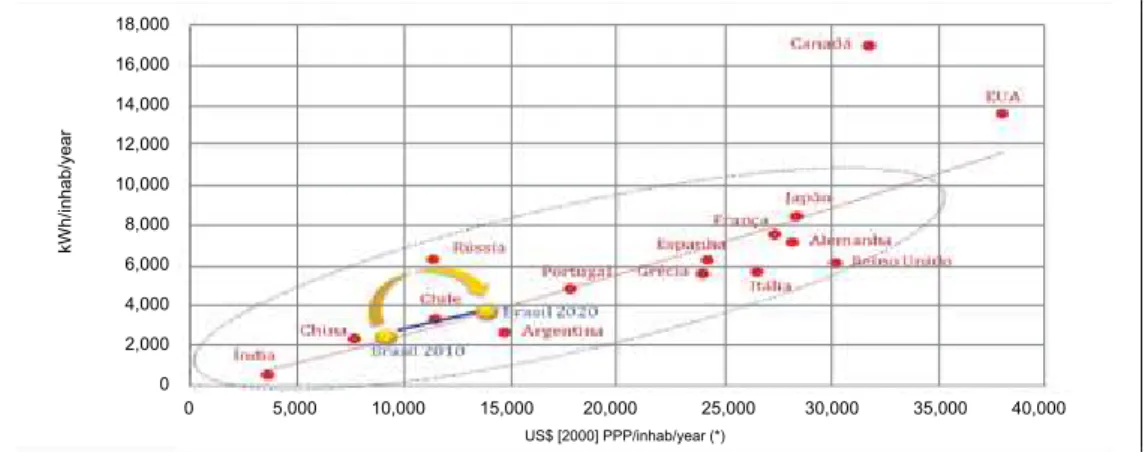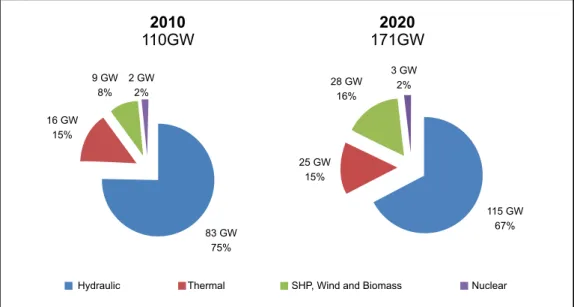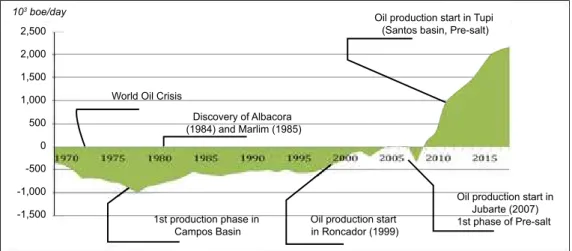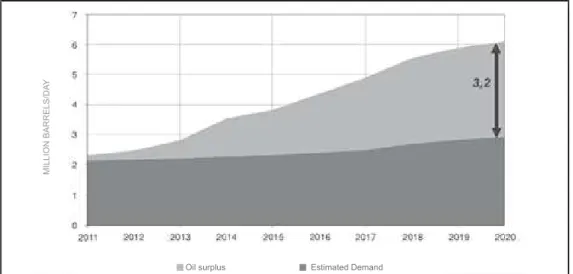the energy sector in Brazil:
Policy and Perspectives
M
auricio
T
ioMno
T
olMasquiM
Introduction
o
nE of the foundations of the economic sustainability of a countryis its capacity to provide logistics and energy for the development of its economic activities, taking into account energy security issues, yet under competitive and environmentally sustainable conditions.
We can say that Brazil has certainly done its “homework” in the energy sector, since it is frequently mentioned as an international reference in the deep-water oil production; ethanol production; its hydroelectric power capacity; the exponential use of wind energy; its extensive and interconnected electricity trans-mission system; and, especially, the renewability of its energy and power mix.
Evolution of domestic energy supply
the achievements of the Brazilian electricity sector are essentially due to the thorough review of the regulatory and institutional framework eight years ago, which ensured favorable conditions for investment, as evinced by the com-petitiveness of the recent wind and hydroelectric power auctions (Rio Madeira and Belo Monte dams).
Energy is perhaps one of the sectors in which the country has more signifi-cantly and iconically restored its capabilities of policy making and execution of planned actions through integrated public-private partnerships.
It is not an exaggeration to say that Brazil today is seen as a global energy and environmental leader. In fact, it is rich in different energy sources. the sup-ply of raw materials and its large-scale production capacity are an example for many countries.
the good news is that Brazil’s energy mix will continue to be an example to the rest of the world in the coming years. the already large share of renew-able energy sources (hydraulic, wind, ethanol, biomass, etc.) in the country’s energy matrix will increase even further in ten year’s time.
according to the Energy Research office (EPE), in the ten-Year Energy Expansion Plan (PdE 2020), the share of renewable energy sources will reach 46.3 percent in 2020, against the 44.8 percent recorded in 2010.
14.2% 9.5% 17.7% 3.4% 38.5% 10.2% 5.1% 1.4% 8.3% 21.8% 3.7% 31.8% 14.4% 6.1% 1.4% 12.5% 439.7 Mtoe 270.6 Mtoe 2020 2010
Coal and derivatives
Other renewable sources
Hydraulic
Natural Gas
Sugarcane Derivatives
Uranium (U308) and derivatives
Oil and derivatives
Firewood and charcoal
figure1–Evolution of the total primary energy supply
Moreover, the share of hydraulic energy as well as of firewood, coal and charcoal will experience a slight reduction, while the share of energy sources like sugar-cane derivatives, especially ethanol, in the energy mix will increase.
despite forecasts that the production of oil and its derivatives will increase in the coming years, their share in the total primary energy supply is expected to drop, since most of the additional supply would be aimed at the external market (exports). as for the domestic market, gasoline will be gradually replaced with hydrated alcohol.
Demand
In the next ten years, the country’s total energy demand should grow 5.3 percent a year, reaching 372 Mtoe in 2020. the industrial and the transporta-tion sectors will continue to rank first in energy consumptransporta-tion, accounting for approximately 67 percent of the overall demand.
However, the largest ten-year growth rate will occur in the energy sector: consumption by refineries and natural gas and oil exploration and production (E&P). In the first case, special mention should be made of the increased re-fining capacity in the country as a result of the establishment of new refineries (e.g., CoMPERJ, RnEst, etc.). In E&P, on the other hand, growth is con-ditional upon the domestic production scenario forecast for the next ten years.
Estimates indicate that in 2020 electricity consumption will be 61 percent higher than in 2010, reaching 730 tWh. the domestic industry plays a major role in this expansion, as it accounts for 138 tWH of the additional 277 tWh of electricity consumption in the period. still, own-use electricity production in the industrial sector grows at rates higher than those of electricity demand in the sector, thus reducing the demand pressure on the expansion of power capacity.
that in 2017 Brazil will recover the maximum level of average residential con-sumption it experienced prior to the energy rationing period (179 kWh/month in 1998).
However, per capita consumption in Brazil is very low when compared to that of other countries. Currently, it equals that of China. With increased per capita consumption, in 2020 Brazil will exceed Chile’s 2007 level, although still far behind france or spain (figure 2).
the fact that energy efficiency stands out in all sectors of the economy will enable avoiding a demand equivalent to 44,000 barrels of oil per day (about one-fourth of the current domestic oil demand) in 2020. Industry will play a major role on energy savings which are expected to reach up to 7% of total en-ergy demand as compared to the Bau scenario.
In turn, energy efficiency gains in the industrial sector between 2010 and 2020 will top 13.8 Mtoe - or the equivalent to 270,000 boe/d - and will
ac-count for 69 million tons of avoided Co2 emissions in the period. the main
players in this scenario will be the pig-iron and steel, ceramics and non-ferrous industries.
18,000
16,000
14,000
12,000
10,000
8,000
6,000
4,000
2,000
0
0 5,000 10,000 15,000 20,000 25,000 30,000 35,000 40,000
US$ [2000] PPP/inhab/year (*)
kWh/inhab/year
figure 2 – Per capita energy consumption vs. per capita income – International comparison
Energy efficiency gains, in turn, will enable the country to save the equiva-lent to the annual electricity generation of a hydro power plant with capacity around 7,000 MW, which corresponds approximately to the installed capacity of the Rio Madeira (Jirau and santo antonio) dams. In other words, the country is expected to avoid the generation of 34 tWh, or 4.4 percent of the total energy demand in 2020.
Electricity generation
Every year EPE releases the ten-Year Energy Plan (PdE) containing the reference case for the expansion of electricity generation, according to environ-mental sustainability and security of supply criteria. this study contributes to the bidding process for the expansion of electricity supply aimed at ensuring adequate energy supply for the country’s growth.
the main objective of the PdE is to prioritize the share of renewable energy sources for the country to meet the increase in electricity consumption within a ten-year horizon. this prioritization is even timelier in new and reserve energy auctions, insofar as renewable energy sources have been presenting quite competitive generation costs already within the ten-year horizon.
special mention should be made of two of the three auctions held in 2010 for the purchase of energy from hydraulic source, as regards both the amount and the price of the energy auctioned. at the auctions, both the Belo Monte (11,233MW) and teles Pires (1,820MW) dams were purchased by the regu-lated market for R$78 and R$58/MWh respectively.
after all, hydraulic energy is a differential element in the Brazilian energy mix. It is the main source of electricity generation in the country, and in 2010 it accounted for 81 percent of the country’s overall energy production.
Moreover, Brazil holds 10 percent of the world’s technical hydro power potential, and taking advantage of this potential is of strategic importance to the country. Hydroelectric power generation is the only one to simultaneously have four extremely relevant attributes: it is renewable; GHG emissions are practically non-existent; it is highly competitive; and in the case of Brazil, plants can be built using virtually 100 percent domestic materials and labor, which translates into income and employment generation in the country.
obviously, the development of any hydro power potential should ensure that resulting environmental impacts are mitigated or offset. In fact, because of the huge progress achieved in recent years, many areas around existing res-ervoirs are currently among the best preserved ones, ensuring the protection of the local biome. In the socioeconomic aspect, the effect of recent projects is noteworthy, as human clusters around these reservoirs have human develop-ment indices higher than those of the regions in which they are included.
thus, from a more contemporary perspective, hydropower plants are more than just power stations. they are, in fact, vectors of regional development and environmental preservation.
Between the years 2016 and 2020, some 19 GW of hydropower plant capacity is expected to be deployed. of this total, 15.5 GW, or 82 percent, will be located in northern Brazil. special mention should be made of the são Luiz do tapajós hydropower plant, with an installed capacity of about 7,000 MW.
cost reductions in recent years. In 2005, at current prices, it was feasible only at R$300/MWh. In the power auctions held in august and september 2011, wind energy was purchased at the average price of R$99/MWh and R$105/ MWh respectively, or one-third of its 2005 reference price.
thus, the market for wind power generation has been a positive surprise. until 2004 the installed capacity was less than 30 MW. In 2016, considering only plants already contracted for, the respective installed capacity will be a little over 8,000 MW. and with the plants, world manufacturers of wind turbines are establishing production facilities in the country. this year alone, new industries are being established which, by the end of 2011 will have increased the wind turbine production capacity from 1,100 MW/year in december 2010 to 3,700 MW/year, almost twice as much as the annual average of wind capacity that has been contracted in the country since 2009 (approximately 1,930 MW/year).
according to EPE’s ten-Year Energy Plan, the installed capacity in the national Grid (known as sIn, its acronym in Portuguese) should increase from around 110 GW (december 2010) to 171 GW (december 2020), with the prioritization of renewable sources (hydro, wind and biomass). despite the ab-solute increase of 22 GW within this time span, the share of hydropower capac-ity will fall from 75 percent to 67 percent, while the share of renewables, such as wind farms, biomass-powered thermal plants and small hydropower plants (sHP), will double in ten years (figure 3).
Hydraulic Thermal SHP, Wind and Biomass Nuclear 2010
110GW
2020
171GW
25 GW 15%
28 GW 16%
3 GW 2%
115 GW 67% 16 GW
15% 9 GW
8% 2 GW
2%
83 GW 75%
figure 3 – Evolution of installed capacity
Wind power capacity will stand out, increasing its share from 1 to 7 per-cent in 2020. thus, the share of renewable sources will remain at around 82-83 percent by the end of the decade.
77 percent (47 GW) of this capacity expansion have already been contracted in power auctions. It is noteworthy that 71 percent of this contracted power capac-ity refers to renewable energy sources (hydro and alternative sources).
By 2014, all electricity needs are contracted, and the existing surplus would, for instance, enable the country to grow at an average rate of 7 percent a year in the period.
this prioritization of hydroelectric plants and renewable energy sources within the planning horizon depends especially on obtaining Previous Environ-mental Licenses required for the planned power plants to participate in power purchase auctions for new projects, as established by law. otherwise, an ex-pansion of thermal power projects, preferably powered by natural gas, could become an alternative for meeting electricity needs vis-à-vis any delays in those planned power projects.
Electricity transmission
the length of the national Grid of 100,000 km in 2010 will increase to approximately 142,000 km in 2020. this means that the equivalent to almost half of the current transmission system will be built in the next ten years. Much of this expansion will come with large transmission trunks associated with the interconnection of plants in the north Region - including Jirau and santo an-tonio on the Madeira River, and Belo Monte - with the rest of the country.
It is also noteworthy the 500kv transmission line between Manaus and Boa vista, that will supply the latter and, in the future will also transport energy generated by the Rio Branco basin hydropower plants in the state of Roraima.
the estimated investment - considering the accumulated in the period 2011-2020 as well as the transmission facilities already tendered that will come into operation in the ten-year period – totals some R$46.4 billion, of which R$30 billion will be invested in transmission lines and R$16.4 billion in substa-tions, including border facilities.
Oil and natural gas
2,500
2,000
1,500
1,000
500
0
-500
-1,000
-1,500 103 boe/day
World Oil Crisis
Discovery of Albacora (1984) and Marlim (1985)
Oil production start in Tupi (Santos basin, Pre-salt)
1st production phase in Campos Basin
Oil production start in Roncador (1999)
Oil production start in Jubarte (2007) 1st phase of Pre-salt
figure 4 – national oil Balance – towards self-sufficiency and export
Pre-salt oil prospects are very promising. these discoveries not only rein-force but also increase the country’s challenge to translate the advantages of its energy mix into real benefits for the well-being of society.
Worldwide experience has shown that the existence of this natural re-source per se does not enable ensuring that the society that owns it will enjoy or appropriate the benefits it may generate. fortunately, today we have much more favorable objective conditions to prevent that from happening in Brazil.
the recent discoveries of pre-salt reserves were due to the technical skills of Petrobras in investigating our underground wealth, and we are sure that Brazilians will count on such skills in the implementation of production systems for oil and natural gas from the new fields. Brazil’s industrial sector is robust in terms of capital, technology and managerial skills.
Moreover, the planned exploration of pre-salt reserves can leverage the socioeconomic development of the entire country, thus favoring the establish-ment of a productive domestic framework capable of surviving the exhaustion of domestic oil reserves.
MILLION BARRELS/DA
Y
Oil surplus Estimated Demand
figure 5 – oil surplus
Besides being a relevant producer, Brazil will become a major player in the international oil scenario. In 2020, about 50 percent of the country’s produc-tion will be earmarked for the internaproduc-tional market, allowing the country, on the one hand, to reap the benefits of the large revenue from oil exports, and on the other to avoid the burden of increasing the share of fossil fuels in the domestic energy mix.
as for natural gas, total domestic supply is expected to increase from 58 million m³/day in 2011 to 142 million m³/day in 2020. of this total, some 69 million m³/day refer to contingent resources and 32 million m³/day to new discoveries. this domestic supply, plus 30 million m³/day of gas imported from Bolivia and 21 million m³/day of LnG will increase total domestic supply from around 109 million m³/day in 2011 to 193 million m³/day in 2020.
It is expected that with the increased oil and natural gas production envis-aged, R/P in Brazil will grow in the first years and stabilize by the end of the decade at least at current levels, with amounts consistent with those observed in major producing regions in the world.
Projections for natural gas demand, when considering the market of lo-cal distribution companies, consumption in refineries and fertilizer plants, will increase from a total of 58 million m³/day in 2011 to 114 million m³/day in 2020. Considering the gas- and biofuel-powered thermal plants at its maximum capacity, these figures rise from about 98 million m³/day in 2011 to 169 million m³/day in 2020.
around R$510 billion are expected to be invested in E&P activities (oil and gas) in Brazil over the period 2011-2020.
pipelines will need to be reinforced; b) between 2013 and 2015, imports of LnG will need to be increased; and c) starting from 2019, a new LnG regasifi-cation unit will need to be established in the northeast region.
therefore, the total expected investment in the natural gas supply infra-structure in the 2011-2020 time span will be around R$9 billion.
In the downstream sector, investments are needed in the expansion and adaptation of the national refinery capacity as well as in the enhancement of the oil and derivatives logistics infrastructure. the main focus on refining aims to meet the growing demand for middle distillates (particularly diesel) and the in-creasingly stricter requirements concerning the quality of derivatives (especially lower sulfur content in diesel and gasoline).
these investments in refining will allow Brazil to overcome the current external fuel dependency (such as diesel) and improve the quality of fuels sold in the domestic market, for the benefit of the Brazilian society. Improving the quality of fuels will also adjust them to the specification standards required by the international market, thus leading to more profitable fuel exports.
It is estimated that in 2020 the country’s net export of derivatives will be approximately 345 barrels per day. Moreover, the country will be a net exporter throughout the period, with an exported volume of nearly half a million cubic meters per day (approximately 3 million barrels per day) in 2020, especially from pre-salt oil fields.
five new refining plants are expected to be established: i) Potiguar Clara Camarão (RPCC), in the state of Rio Grande do norte; ii) abreu e Lima (RnEst), in Pernambuco; iii) Petrochemical Complex of Rio de Janeiro (CoMPERJ), in Rio de Janeiro; iv) Premium I, in Maranhão; and v) Premium II, in Ceará. With these new facilities, the nominal refining capacity will increase from the current 2 million barrels per day to 3.5 million barrels per day in 2020. Investments in logistics infrastructure (pipelines, ships, terminals, etc.) have also been planned, in order to meet the growing need for the transporta-tion of oil and derivatives. total investment in the petroleum derivatives supply (including refining and logistics) will amount R$167 billion until 2020.
Biofuels
Biomass is another important energy source in Brazil, since most of the country’s territory is situated in the region where the production of biomass tends to be the largest on the planet.
In terms of bioenergy, sugarcane stands out due to technological advances both in the agricultural and industrial phases, thus promoting the competitive-ness of ethanol and bioelectricity in the country.
Brazilian consumers was such that a mere eight years after their introduction in 2003, the number of flex-fuel vehicles already accounts for 49 percent of the light-duty vehicle fleet, i.e., about 15 million units. this share is expected to reach 78 percent in 2020.
for the next ten years, the demand for ethanol in the Brazilian market will continue to grow, due to the significant expansion of the domestic fleet of flex-fuel vehicles and the high competitiveness of hydrated ethanol prices in relation to gasoline, despite its restricted supply in the short-term. In the international market, Brazil should continue to maintain its leadership position in ethanol sales.
In the medium term, increased supply will meet the demand for etha-nol through the expansion of sugarcane plantations, the expansion of ethaetha-nol production plants, as well as the use of new technologies, which will improve the efficiency of the entire ethanol production chain. under this point of view, projects aimed to facilitate and reduce ethanol transportation and storage costs have also been planned.
Biodiesel, in turn, will be used only to meet the mandatory blend. analysis of the availability of raw materials and of the production processing and outflow capacity shows that Brazil has already created the necessary conditions to meet this demand.
as regards sugarcane biomass for bioelectricity generation, an assessment of the amount of energy already contracted shows that there is significant room for capacity expansion, which would enable consolidating this biomass as an important source in the country’s power mix, in accordance with the guidelines set for capacity expansion through renewable sources. the current potential, estimated at 9.6 GW, should increase to a little over 17 GW in 2020.
Investments in biofuels, mostly in ethanol supply, are expected to total R$97 billion by end of this decade.
Environment
the Brazilian energy policy is guided by goals that aim to ensure the entire population access to quality services at fair prices, while fulfilling strict com-mitments to environmental preservation and the sustainable management of natural resources. this policy contributes to promoting the economic and social progress of the population, as well to maintaining one of the cleanest energy matrices in the world.
the concern about external dependence on fossil fuels has led to a greater diversification of energy sources, with a clear preference for renewable and low environmental impact sources. today Brazil is recognized internationally as a pioneer in the development of efficient and environmentally sustainable energy sources, with an emphasis on ethanol.
social-environ-mental sustainability. the focus on more sustainable alternatives is guided by current international discussions and negotiations on climate change, as seen in CoP-15 held in Copenhagen, denmark, and ratified in the Cancun Conference (CoP-16). the commitments undertaken by Brazil in those negotiations were formalized in Law 12.187/09, which establishes a voluntary target for the miti-gation of greenhouse gas emissions for the year 2020, taking the discussions on climate change in Brazil to a new institutional level.
In this context, the PdE 2020 is an important tool for developing the mitigation scenario, since it incorporates measures which, as a set, contribute to reducing GHG emissions from energy production and consumption. In-crease energy efficiency, enhance the installed hydropower park and alternative energy sources such as wind, biomass and sHP, coupled with an assessment of the sugarcane expansion areas required to increase the biofuels production and the consequent replacement of fossil fuels, are among the measures adopted that will enable the country to remain at the same levels of emission intensity recorded in 2005.
therefore, we can conclude that the continued use of the country’s hy-dropower potential and the expansion of other renewable energy sources for en-ergy production such as wind farms and bioenen-ergy - for both electricity produc-tion and the supply of liquid fuels - are elements that allow Brazil to maintain clean its energy mix. Moreover, increased domestic oil and natural gas produc-tion will enable the country to consolidate itself as an important player in the international energy scene. thus, the essential ingredients for Brazil to become an environmental and energy world leader in the twenty-first century are already in place.
absTracT – the article presents an overview of the Brazilian energy sector through up-to-date statistics regarding the evolution of the domestic supply of energy up to the year of 2020. In particular, it addresses the electricity sector, showing the current situation and development of the installed capacity. It also addresses the issues of pe-troleum, natural gas and biofuels. the article makes it clear that it would not have been possible to maintain the high Brazilian economic growth that has occurred over the past years without a growing supply of energy. for this reason, many and diverse long-term investments have been made, such as the construction of hydroelectric and thermal power plants; wind farms; pipelines; energy conservation measures; and the expansion of electricity transmission systems, among other ventures.
Mauricio Tiomno Tolmasquim holds a degree in Production Engineering and a Mas-ter’s degree in Energy Planning from the federal university of Rio de Janeiro, as well as a degree in Economic sciences from the state university of Rio de Janeiro. He also holds a Phd in Socio-Economie du Développement from the École des Hautes
Études en Sciences Sociales (france). He is an associate professor at the Engineer-ing Graduate and Research Institute, federal university of Rio de Janeiro (Coppe/ ufRJ) (on leave). He is currently president of the Energy Research office (EPE). @ – mauricio.tolmasquim@epe.gov.br



